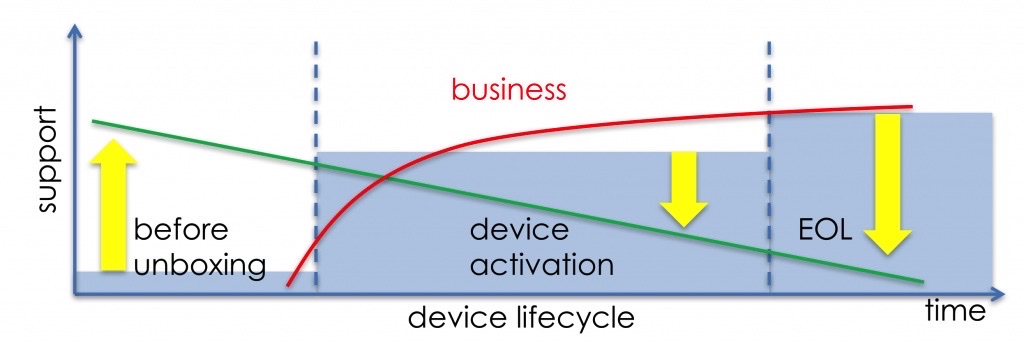In this first post of the year I would like to share some thoughts on the enrollment of devices. This is the first action your employees take when they sign up for the mobile IT program to get mail, intranet, apps … and most of the time it’s not the best experience – time to change that. Our objective for 2017 is to make the enrollment or activation of the mobile devices a 0-effort, easy and fail-safe!
How are we going to do that? By taking a very close look how consumer smartphones are sold today… Think about how you installed a new PC a few years ago, after plugging in the hardware and figuring out what connector goes where, you booted the system and it asked for OS installation disks… It was a nightmare for most consumers and only the IT savvy few got their system to work – others called in help. Imagine if Apple or Samsung shipped their smartphones and tablets with the message “please assemble, boot, insert an OS and good luck!”. The user experience but fail all the way and the volumes these companies have set in their targets would never be met.
So how do they achieve a better user experience? The way they approach the device activation is to minimise the user intervention – what can be preloaded on the device will be preloaded and settings we already know (or can derive from others) will be set. It sounds all very simple, and the result is, the preparation is however a complex and labor intensive job.
When we take the next step and use these very same devices for our business, most of us aren’t performing all that well. We ask our users to enter URL’s, download apps, set their username/password in multiple fields, … and every action we ask from them opens a new opportunity for a failed registration. The further our users move in the registration process the more complex issues occur and the more expensive support becomes.

In the above schematic I have visualised 3 important phases in the device lifecycle, you would only expect the middle ‘run’ phase and final End-of-Life, but I have added a first one that comes BEFORE the unboxing of the device. That’s right, before the employee removes the thin foil and switches on the device for the first time. The green line indicates the effort device manufacturers are putting in when delivering new devices, that’s a lot before they actually ship the devices – and reduces over time to 0. They don’t care too much about the EOL of your consumer device.
Typically in business, the trend is reverse, we don’t think about the device until the moment it contains our information, and we see support increasing over time – we do worry about the EOL and full wipe of all enterprise data before the device is traded on a second hand market. That’s the red line on the graph.
Our mission for 2017 is to put more effort in the configuration of the devices BEFORE these are unboxed. The reason is simple: efforts BEFORE the activation are valid for all, efforts AFTER the activation are device-per-device support – we need this economy of scale to win.
With the Apple and Samsung Device Enrollment Program we have now the tools to do just that! We can take control over the device during the activation and steer it towards our management server to ensure correct, easy and direct registration. Yes, it takes more brain power to define the activation process, to technically describe every step of the registration process, configuration, apps, … but it does put the user experience on the next level.
Interested to learn how we can guarantee 100% success in device registration with 0-support efforts? Curious how even the most non-tech people will be able to activate their smartphone for business without any assistance?
> Contact us for more information on the Device Enrollment Program
> Check our mobco academy schedule for workshops on the latest deployment practices
